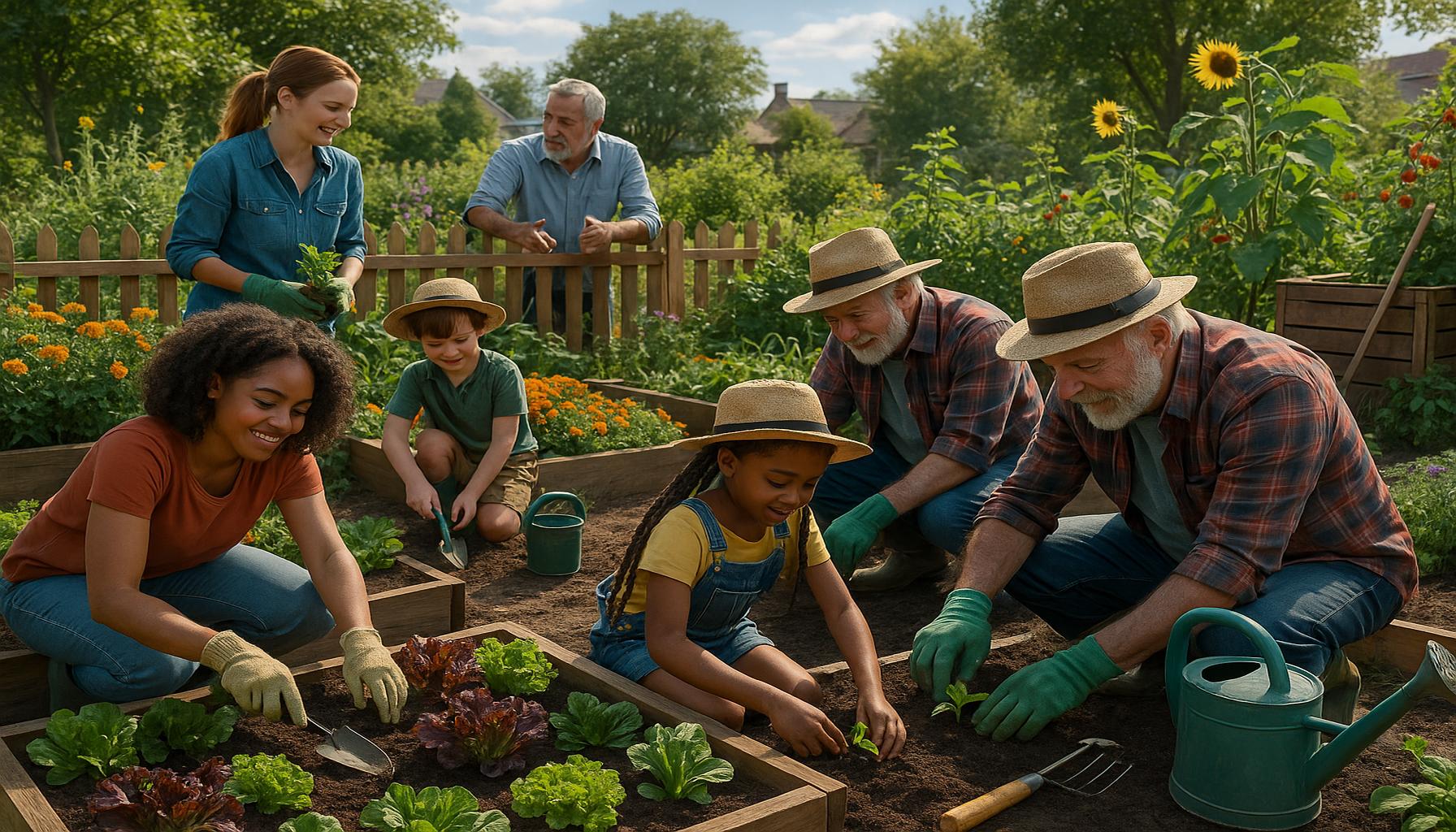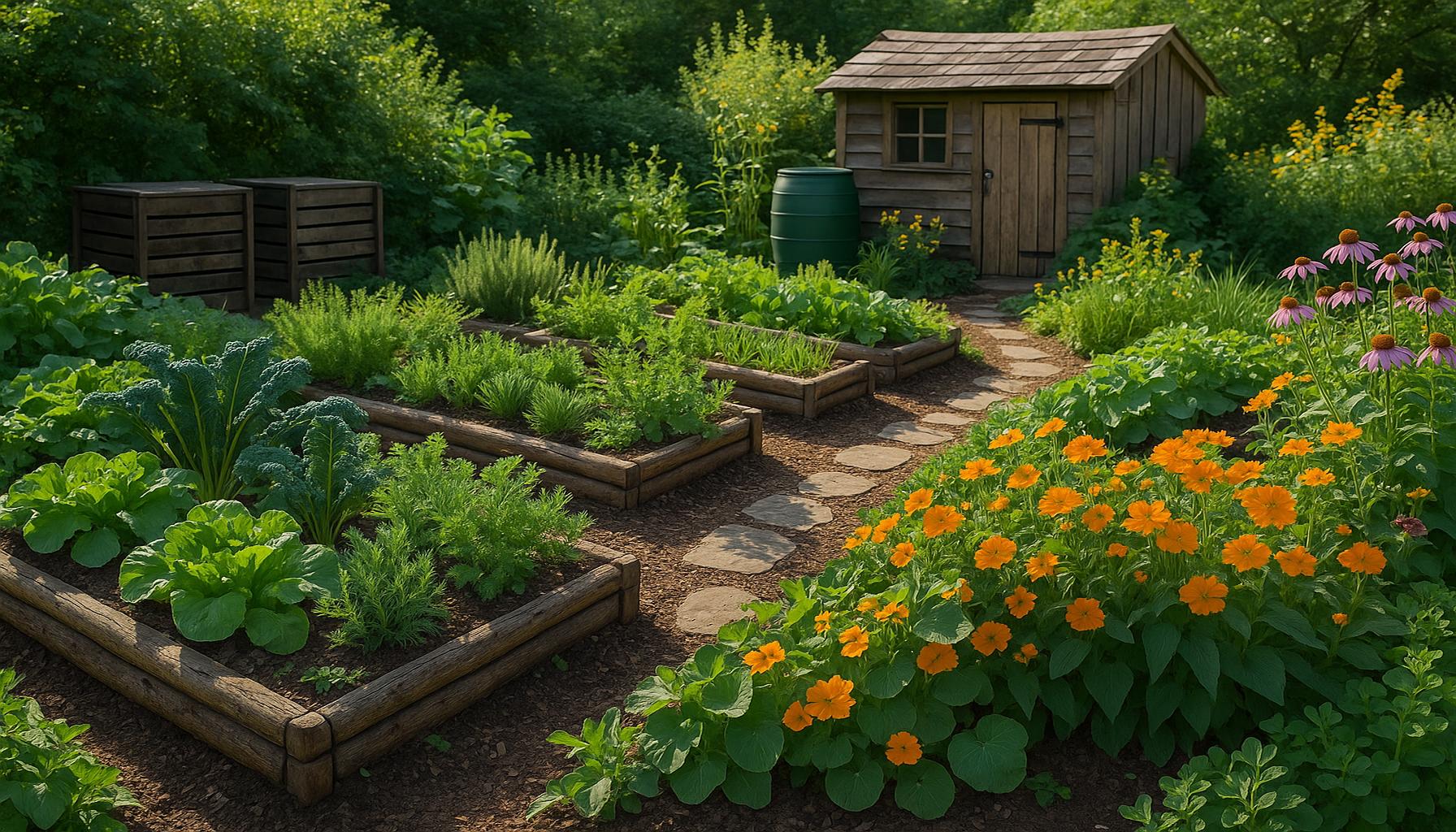Community Gardening: Strengthening Bonds and Promoting Sustainability in Neighborhoods

The Role of Community Gardening in Urban Spaces
As urban areas continue to expand, the need for green spaces has become increasingly vital. Community gardens not only serve as a remedy for this issue, but they also play a pivotal role in enhancing urban living through environmental and social benefits. These gardens operate at the intersection of ecology and community, providing a platform for locals to engage actively in their surroundings while promoting sustainable practices.
Environmental Sustainability
One of the most significant advantages of community gardening is its contribution to environmental sustainability. Urban gardens enhance biodiversity by creating habitats for various species, including birds, bees, and butterflies, which are essential for pollination. For instance, a community garden in the Bronx has been recognized for its efforts in incorporating native plants that attract local pollinators, thereby improving the ecosystem’s health.
Moreover, these gardens play a role in mitigating urban heat island effects, where cities experience significantly warmer temperatures than surrounding rural areas due to human activities. The presence of vegetation helps to cool the environment, making neighborhoods more livable during hot summer months. In cities like Portland, Oregon, local initiatives have even introduced green roofs and wall gardens, showcasing innovative ways community gardening is being integrated into urban architecture.
Enhancing Food Security
In many urban neighborhoods, access to fresh produce is limited, creating what are known as food deserts. Community gardens are crucial in addressing this issue by providing residents with the opportunity to grow their own food. For example, the community gardening program in Chicago has effectively transformed vacant lots into flourishing gardens, ensuring that fresh fruits and vegetables are available within walking distance for community members.
Gardening workshops hosted by these initiatives often educate participants on growing food sustainably, teaching them about heirloom varieties and organic gardening techniques. This not only encourages self-sufficiency but also fosters a culture of healthy eating, which is increasingly important in combating the rise of diet-related health issues in urban areas.

Promoting Social Cohesion
Beyond the tangible benefits of fresh produce and environmental enhancement, community gardens are vital for social cohesion. They provide a space where individuals from diverse backgrounds can come together, share experiences, and build relationships. In San Francisco, for instance, garden organizers host regular community events that invite residents to collaborate on planning and maintaining the space. These gatherings are not only productive but also foster friendships and create a shared sense of accomplishment.
Furthermore, community gardens reduce social isolation, particularly among vulnerable populations such as elderly residents and low-income families. By offering a physical space for interaction, they help bridge the gap between different cultures and communities, promoting understanding and cooperation. This phenomenon has been noted in various analyses, showing that participation in community gardening initiatives leads to improved mental well-being and community pride.
Conclusion
Community gardening is much more than just a hobby or a means of producing food; it is a multifaceted approach to fostering community resilience and environmental stewardship. As we explore the various case studies and insights into these green spaces, it becomes evident that they hold significant potential for creating healthier, more connected urban environments in the United States. By investing time and resources into these community-driven projects, residents can sow the seeds of change that promise to yield not just produce, but a thriving, cooperative community spirit.
Join us as we delve deeper into this grassroots movement, discovering inspiring stories and actionable strategies that can empower neighborhoods everywhere to cultivate their own community gardens.
DIVE DEEPER: Click here to uncover powerful writing techniques
Benefits of Community Gardening
Community gardening provides a wealth of benefits that extend beyond simply growing fruits and vegetables. These advantages echo across various disciplines, all contributing to the creation of sustainable and interconnected urban landscapes. By examining these benefits, one can appreciate the multifaceted impact community gardens have on neighborhoods and their residents.
Educational Opportunities
Community gardens serve as outdoor classrooms, offering invaluable educational opportunities for participants of all ages. From children learning about the science of plant growth to adults mastering sustainable agriculture techniques, these spaces promote an environment of shared learning. Many community gardens partner with local schools, allowing students to engage in hands-on science lessons that emphasize ecology, biology, and nutrition.
Workshops often focus on a variety of topics, including:
- Soil health and composting
- Organic pest control
- Seasonal planting schedules
- Nutrition and cooking classes
By equipping community members with knowledge about gardening practices and healthy eating, these gardens empower individuals to make informed decisions regarding their food choices and environmental impact.
Economic Benefits
In addition to their social and educational advantages, community gardens can also deliver economic benefits. Many urban areas are grappling with high food prices and limited access to nutritious options. Community gardens help alleviate these economic pressures by providing fresh produce at little to no cost to participating families. This not only boosts food security but also reduces household expenses, allowing families to allocate funds toward other essential needs.
Furthermore, these green spaces can increase property values in the surrounding neighborhood. Research has shown that homes located near community gardens can appreciate in value more quickly than those in areas lacking green spaces. This economic impact can enhance the quality of life for residents and attract new families seeking a vibrant community.
Environmental and Health Benefits
Community gardening also plays a critical role in promoting both environmental and health benefits. The act of growing food locally reduces dependence on large-scale agriculture, which is often associated with high carbon emissions from transportation. By shortening the supply chain, community gardens significantly lessen their carbon footprint and encourage a more sustainable lifestyle.
Moreover, engaging in gardening has been linked to numerous health benefits. Studies have revealed that participation in garden activities leads to increased physical activity and improved mental well-being. The physical labor involved in gardening promotes cardiovascular health, while the act of nurturing plants is known to reduce stress and anxiety levels. This holistic approach to health fosters a sense of well-being and highlights the interconnectedness of environment, physical activity, and mental health.
In essence, community gardening is a powerful tool that drives social interaction, educational development, economic improvement, and environmental sustainability. As urban landscapes transform and evolve, the role of community gardens becomes increasingly integral to nurturing stronger, more resilient neighborhoods. By encouraging communities to connect with one another and the Earth, these gardens pave the way for a more sustainable future, one plot at a time.
| Advantage | Impact |
|---|---|
| Enhanced Community Relationships | Community gardening initiatives foster social connections by bringing individuals together, allowing them to share resources and knowledge. |
| Environmental Benefits | These gardens actively promote sustainability through increased biodiversity and decreased carbon footprints, leading to healthier neighborhoods. |
By establishing community gardens, neighborhoods not only enhance their green spaces but also create inclusive environments where individuals of all backgrounds can participate and thrive. This collaborative effort often results in shared meals, cultural exchanges, and stronger local networks, as participants celebrate their collective achievements. Moreover, community gardens are instrumental in teaching sustainable practices that can be adopted in everyday life, such as composting and organic gardening. These educational elements contribute significantly to enhancing the overall awareness of environmental issues within communities. By investing time and energy, residents invest in their own well-being as well as the health of the planet. As these gardens grow, they become vital centers of learning and innovation, encouraging residents to explore topics like plant care, nutrition, and even eco-friendly landscaping. The impact of a well-maintained community garden can ripple through the neighborhood—transforming not just the landscape but also the community’s social fabric and environmental consciousness.
DIVE DEEPER: Click here to learn more about the evolution of digital art
Community Engagement and Social Cohesion
Community gardening not only enriches the landscape but also serves as a catalyst for community engagement and social cohesion. These shared spaces create opportunities for individuals from diverse backgrounds to come together, fostering a sense of belonging and shared purpose. Community gardens often serve as gathering spots where neighborhood residents can exchange ideas, traditions, and resources, thereby enhancing social interactions.
From organizing potlucks to celebrating harvest festivals, volunteer days become communal events that instill pride and ownership in local spaces. In cities like San Francisco, the “Garden for the Environment” program illustrates how community gardens can be instrumental in building connections among residents. These community exchanges not only strengthen neighborhood ties but also create networks of social support, whereby participants feel a deeper sense of commitment to the place they call home.
Fostering Biodiversity
Another critical aspect of community gardens is their potential for fostering biodiversity in urban environments. By transforming vacant lots or neglected spaces into vibrant gardens, urban dwellers can create ecosystems that attract various pollinators, birds, and beneficial insects. The diversity of plants cultivated within these gardens contributes positively to local ecology, helping to preserve native species and provide habitats for wildlife.
According to the American Community Gardening Association, over 2 million people in the U.S. engage in community gardening. This collective effort results in a notable increase in green areas across metropolitan areas, which are vital to reducing the urban heat island effect, improving air quality, and enhancing stormwater management. By encouraging biodiversity, community gardens also play an important role in sustaining local food systems and adapting to climate change.
Cultural Exchange and Diversity
Community gardening also serves as a platform for cultural exchange and showcasing diversity. In cities such as New York and Los Angeles, community gardens reflect the rich tapestry of immigrant communities, allowing individuals to cultivate plants and crops that have cultural significance. Gardens often become a place where participants can share traditional recipes, gardening techniques, and customs, invoking a spirit of collaboration and understanding.
For instance, community gardens in New York City host “cultural days” where gardeners can showcase dishes made from the produce they grow, providing an opportunity for residents to experience and learn about different culinary traditions. Such initiatives not only celebrate diversity but also emphasize the universal benefit of food as a uniting force in communities. These exchanges help break down barriers and build bridges among neighborhoods, promoting inclusivity and mutual respect.
Resistance Against Urbanization
In a time when urbanization poses threats to green spaces, community gardens emerge as a form of resistance against encroaching development. Neighborhoods often rally around these gardens to advocate for their preservation when faced with gentrification or commercial development. This grassroots activism empowers residents to protect their green spaces that provide not just food, but also a sense of identity and community.
City planners and policymakers increasingly recognize the importance of community gardens as vital public assets. In cities like Seattle and Portland, inclusive policies seek to safeguard existing urban gardens and create new ones as integral components of urban development strategies. By acknowledging the value of community gardens, local governments can help build resilience within neighborhoods, ensuring that cherished green spaces continue to flourish amidst rapid urban growth.
Ultimately, community gardens are much more than patches of cultivated land; they are dynamic spaces that bolster social connections, foster biological diversity, and help anchor cultural identities within urban settings. As they continue to thrive in cities across the United States, these gardens are integral to promoting sustainability and strengthening the bonds that unite neighborhoods.
DISCOVER MORE: Click here to dive deeper
Conclusion: The Future of Community Gardens
As we explore the multifaceted benefits of community gardening, it becomes clear that these green spaces are not merely patches of cultivated land; they represent a significant movement toward sustainability, inclusivity, and resilience in urban settings. The cultivation of community gardens fosters not only environmental awareness but also a profound sense of community engagement and cultural exchange. In an era where urbanization threatens to overshadow green spaces, community gardens serve as powerful symbols of resistance, empowering residents to advocate for their neighborhoods and preserve their identities.
Moreover, the collaborative nature of community gardening encourages social connections, bridging divides among diverse populations. By gathering individuals from various backgrounds to cultivate plants that are often culturally significant, these gardens highlight the importance of inclusivity and collaboration. Beyond simply producing food, community gardens create spaces for learning, sharing experiences, and building trust among neighbors.
Looking forward, it is essential for city planners, local governments, and community members to continue supporting the proliferation of these vital green spaces. Investments in policies that protect and promote community gardening will ensure that the benefits of biodiversity, local food systems, and social cohesion continue to flourish for generations to come. As residents nurture their gardens, they simultaneously nurture their neighborhoods, contributing to a greater vision of sustainability and community resilience. It is time to recognize community gardens as integral components of urban life and to advocate for their continued growth and celebration.


